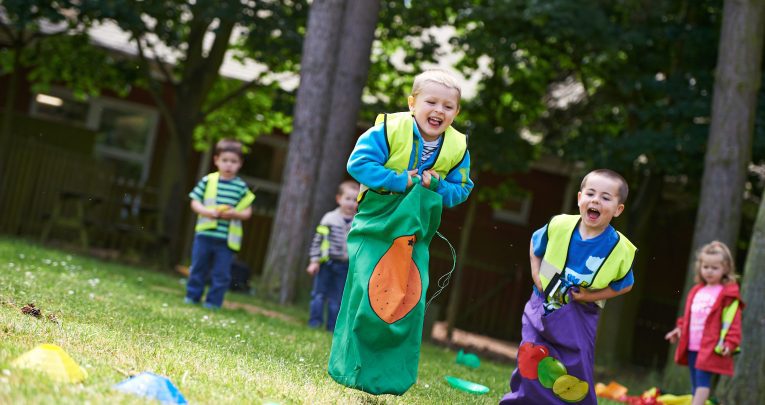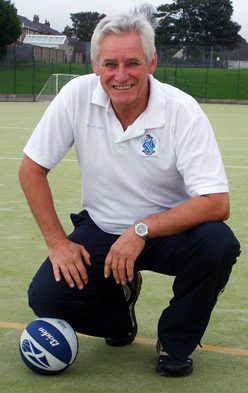Body Talk – The Importance Of Physical Literacy in Early Years

Young children must acquire a vocabulary of movement as they grow, and structured activities have an important role to play in helping them succeed, says Dr Jim Lavin…

- by Dr Jim Lavin

Given the need for a seamless transition into Key Stage 1 made apparent in the EYFS profile handbook, it’s hard to argue against nursery and preschool settings allocating time and funding to introduce children to organised physical activity – as opposed to solely offering play-based physical development.
Such activity can encompass basic games skills, opportunities to get to grips with items of sporting equipment and even an element of competition. The key elements of games play can be taught within the Physical Development requirement of the EYFS, particularly to 3–5-year-olds – basic movement skills that include throwing, kicking, aiming, catching, dribbling, bouncing, striking and collecting. These abilities are an essential part of young children’s developing physical literacy.
What is physical literacy?
The best analogy is with literacy itself. Instead of letter recognition leading to the development of words that are then put together into coherent sentences, children build up a vocabulary of movement. The learning of a single action can lead to a sequence of actions, which is gradually used to develop a range of movements.
There is support for this notion across a spectrum of government bodies linked to physical education and sport. Indeed, Sport Wales has stated that “Physical literacy is as important as reading and writing”. The Youth Sport Trust also recognises the importance of physical literacy in early years. Their advice to providers is to create environments that introduce and develop control and coordination for both large and small movements. This can be achieved through both structured and free play, and helps children to move confidently in a range of ways.
Movement skills & free play
The problem with free play is that it’s a very ineffective way of achieving real progress and quality in terms of skill learning. Children don’t pick up fundamental movements naturally as part of normal growth and development. It’s estimated that it takes between 240 and 600 minutes of instruction time to become proficient in one fundamental movement skill.
Moreover, the best time for the development of fundamental movement skills is the early years (Lavin 2002). Without the teaching of some elements of skill development, children moving up from Reception may struggle to meet the requirement to “participate in team games, developing simple tactics for attacking and defending” set out in the National Curriculum for KS1. As such, the current focus on play-centred learning through exploration and experimentation could prove detrimental to the transition at KS1 to a more focused, teacher-directed and subject-based approach. Conversely, a focus on developing games skills for 3–5-year-olds would feed quite naturally into the multi-skills approach taught in many schools at KS1.
Investing in specialists
As with teachers in KS1 and 2, many early years practitioners do not feel that they have the necessary knowledge and understanding to promote skill learning in a games context.
An obvious response to this is to use physical education specialists or coaches to lead and structure this learning. Thanks to the physical education and sport premium, coaches are now a common sight in our primary schools, and they offer a credible alternative to the lack of skill learning in early years settings, provided that they are appropriately trained and briefed to work with the age group in question. In many early years settings this approach is already in place, with coaching available for a wide range of sports, from football and tennis, to badminton swimming and more.
Types of activity
Movement education or physical literacy can involve a wide range of learning experiences for the children in early years settings. The programme of study for KS1 provides inspiration: it identifies the main characteristics of Agility, Balance and Coordination (the ABCs of movement). Within this framework it is possible to categorise the following skills:
Stability Turning, twisting, freezing, stretching, curling, landing and pivoting
Locomotor Walking, running, jumping, skipping, galloping, bounding and hopping
Object control Throwing, kicking, catching, dribbling, bouncing, striking and collecting
It’s not possible to fully explore the range of active learning experiences of all three areas within the confines of this article, so what follows are some examples of the type of activity that would come under the heading of ‘object control’.
Object control
Aiming games: This type of activity is best suited to the 3–5-year-old age group. It provides a ‘closed skill’ in that the aiming skill takes place from a stable position rather than on the move. Likewise, the target is still and the children are likely to learn from experience and improve their aim.
Children can use a variety of ways to send the object, such as underarm throwing, kicking, bowling and pushing. The target can be adjusted to present a challenge but also to ensure success. This activity also benefits from being helpful in assessing and evidencing the progress of the children. A visual record of the ability of the children could be taken by videoing the children’s first and then later attempts; iPads are ideal for this, because they allow children to view and evaluate their attempts.
Getting used to a ball: Children should be encouraged to watch the ball whenever possible, use their fingers to control the ball and use two hands at first. Activities could include rolling the ball around different parts of their body and using different parts of the body to hold the ball, such as elbows, knees and feet.
Other progression includes moving the ball from one hand to another, rolling the ball along the ground and running to catch up with it, throwing the ball into the air above their head and letting it bounce a number of times before picking it up. In all of these activities it’s important for the children to have a ball each that’s appropriate to their size and skill level.
Spatial awareness: Set out some markers in a line. The children start at one end and steer a ball in and out of the markers until they come to the end. Children can steer with their hands first, then progress to steering with feet or a bat.
Looking ahead
As children grow and continue to practise such activities, their abilities will develop. Here are the milestones the 3–5-year-old age group can be expected to reach:
Three-year-olds Change speed, direction or type of movement; throw an object without losing balance; catch a large or bounced ball with both arms extended.
Four-year-olds Start, stop, turn and change direction around objects; throw with an overarm movement; bounce a ball; catch by trapping a ball to the chest.
Five-year-olds Catch a thrown ball with both hands; intercept a moving ball; throw the ball with direction and force; play simple 1v1 games.
Taking this kind of approach to skill learning is important, because the skills outlined are the building blocks for more complex skills that are required by children to succeed in future sporting endeavours. Children who develop effective games skills at this stage are much more likely to continue to play a range of games/sports in later life, too. Children want to be active and to learn physical skills – so let’s give them the opportunity to do just that.
An Early Olympics
Planning a day dedicated to sport can be a great way to introduce new skills and experiences
An idea that has proven successful in supporting physical development in many early years settings is that of a ‘games festival’. This involves organising fun, active ‘stations’ that allow children to try their hand at a range of different games skills. Using this approach, children can be given the freedom to try apparatus and equipment that both interests and challenges them. It’s well worth seeking out or investing in ‘new’ games equipment that will be novel to the children for this kind of special event. This could be acquired through the local school sports partnership, a coaching firm or even other local primary/secondary schools.
Dr Jim Lavin is an award-winning PE consultant and trainer, and formerly head of physical education at the University of Cumbria and professor of health and physical education at Eastern Connecticut State University; for more information, visit jimlavin.co.uk
Browse more Early Years activities.










